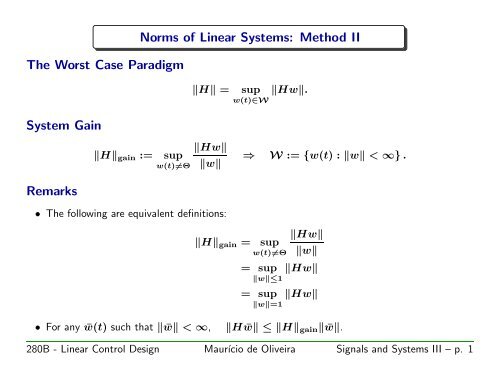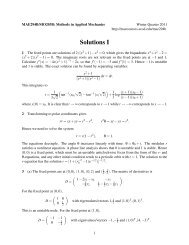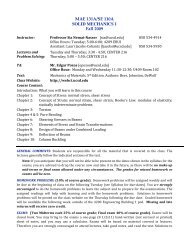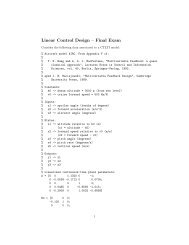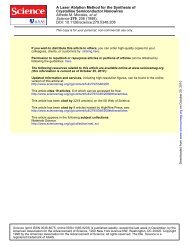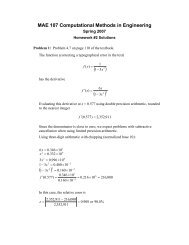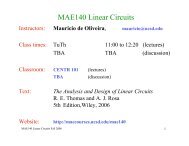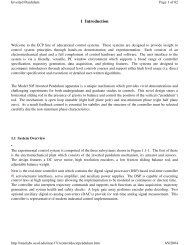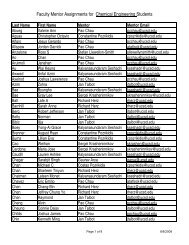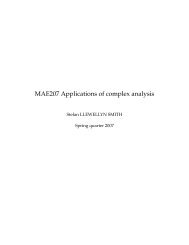Norm 3
Norm 3
Norm 3
You also want an ePaper? Increase the reach of your titles
YUMPU automatically turns print PDFs into web optimized ePapers that Google loves.
The Worst Case Paradigm<br />
System Gain<br />
Remarks<br />
<strong>Norm</strong>s of Linear Systems: Method II<br />
Hgain := sup<br />
w(t)=Θ<br />
H = sup<br />
w(t)∈W<br />
Hw.<br />
Hw<br />
w<br />
• The following are equivalent definitions:<br />
Hgain = sup<br />
w(t)=Θ<br />
⇒ W := {w(t) : w < ∞} .<br />
Hw<br />
w<br />
= sup Hw<br />
w≤1<br />
= sup Hw<br />
w=1<br />
• For any ¯w(t) such that ¯w < ∞, H ¯w ≤ Hgain ¯w.<br />
280B - Linear Control Design Maurício de Oliveira Signals and Systems III – p. 1
Definition (SISO system)<br />
Definition (MIMO system)<br />
L2 − L2 Gain<br />
H∞ := sup<br />
ω<br />
H∞ <strong>Norm</strong><br />
H∞ := sup<br />
ω<br />
|H(jω)|.<br />
H(jω), H(jω) 2 = λmaxH(jω) ∗ H(jω).<br />
HL2−L2 := sup<br />
w(t)=Θ<br />
Hw2<br />
.<br />
w2<br />
Proposition For an asymptotically stable linear system HL2−L2 = H∞.<br />
280B - Linear Control Design Maurício de Oliveira Signals and Systems III – p. 2
On the Frequency Domain:<br />
Compute<br />
On the Time Domain:<br />
Compute<br />
Computing the H∞ <strong>Norm</strong><br />
H 2<br />
∞<br />
= sup<br />
ω<br />
H(jω).<br />
H∞ = Hwwc2, wwc := arg sup<br />
w2=1<br />
Hw2.<br />
280B - Linear Control Design Maurício de Oliveira Signals and Systems III – p. 3
Bounded Real Lemma<br />
Computing the H∞ <strong>Norm</strong><br />
Consider the asymptotically stable CTLTI system with minimal realization<br />
H(s) = C (sI − A) −1 B + D and null initial conditions. There exists P ∈ Sn such that<br />
⎡<br />
⎤<br />
if, and only if, H∞ < µ.<br />
P ≻ Θ,<br />
⎢<br />
⎣<br />
A T P + P A P B C T<br />
⎥<br />
⎦ ≺ Θ<br />
C D −µI<br />
B T P −µI D T<br />
280B - Linear Control Design Maurício de Oliveira Signals and Systems III – p. 4
Computing the H∞ <strong>Norm</strong><br />
Proof (Sufficiency) Define the quadratic Lyapunov function V (x) := xT P x, P ∈ Sn and<br />
its time-derivative<br />
˙V (x) = 2x T P Ax + x T ⎛<br />
P Bw = ⎝ x<br />
⎞T<br />
⎡<br />
⎠ ⎣<br />
w<br />
AT P + P A P B<br />
BT ⎤ ⎛<br />
⎦ ⎝<br />
P Θ<br />
x<br />
⎞<br />
⎠ .<br />
w<br />
Assume that the BRL holds and apply Schur complement to obtain<br />
⎡<br />
⎣ AT P + P A + µ −1 C T C P B + µ −1 C T D<br />
B T P + µ −1 D T C −µI + µ −1 D T D<br />
⎤<br />
⎦ ≺ Θ.<br />
280B - Linear Control Design Maurício de Oliveira Signals and Systems III – p. 5
Notice that for all w(t) ∈ L2<br />
⎡<br />
⎡<br />
Computing the H∞ <strong>Norm</strong><br />
⎣ AT P + P A + µ −1C T C P B + µ −1C T D<br />
BT P + µ −1DT C −µI + µ −1DT D<br />
⎣ AT P + P A P B<br />
B T P Θ<br />
⎤<br />
⎦ ≺ µ<br />
⎛<br />
⎝<br />
⇓<br />
x<br />
⎞T<br />
⎡<br />
⎠ ⎣<br />
w<br />
AT P + P A<br />
B<br />
P B<br />
T P<br />
⎤ ⎛<br />
⎦ ⎝<br />
Θ<br />
x<br />
⎞ ⎛<br />
⎠ < µ ⎝<br />
w<br />
<br />
˙V (x)<br />
<br />
x<br />
⎞<br />
⎠<br />
w<br />
⎡<br />
⇕<br />
⎤<br />
⎦ ≺ Θ,<br />
⎣ −µ−2C T C −µ −2C T D<br />
−µ −2DT C I − µ −2DT D<br />
T ⎡<br />
⎤<br />
⎦ ,<br />
⎣ −µ−2C T C −µ −2C T D<br />
−µ −2DT C I − µ −2DT D<br />
⎤ ⎛<br />
⎦ ⎝ x<br />
⎞<br />
⎠ .<br />
w<br />
<br />
w T w−µ −2 z T z<br />
280B - Linear Control Design Maurício de Oliveira Signals and Systems III – p. 6
Integrating<br />
on both sides<br />
Computing the H∞ <strong>Norm</strong><br />
∞<br />
0<br />
˙V (x) < µ w T w − µ −2 z T z <br />
˙V (x) dt < µ<br />
V (x(∞)) − V (x(Θ)) < µ<br />
∞<br />
0<br />
∞<br />
0<br />
w T w − µ −2 z T z dt,<br />
w T w − µ −2 z T z dt.<br />
280B - Linear Control Design Maurício de Oliveira Signals and Systems III – p. 7
Computing the H∞ <strong>Norm</strong><br />
Since the system is asymptotically stable, the output z(t) ∈ L2 for all w(t) ∈ L2. Using the<br />
minimality of the realization<br />
z(t) ∈ L2 ⇔ x(t) ∈ L2 ⇒ x(∞) = Θ ⇒ V (x(∞)) = 0.<br />
From the null initial conditions V (0) = 0. Hence<br />
∞<br />
0<br />
Consequently<br />
w T w − µ −2 z T z dt > 0 ⇒<br />
∞<br />
w<br />
0<br />
T w dt > µ −2<br />
∞<br />
0<br />
z2 < µw2, ∀w(t) ∈ L2 ⇒ µ > H∞<br />
since z2 = Hw2 ≤ H∞w2 for all w(t) ∈ L2.<br />
z T z dt.<br />
280B - Linear Control Design Maurício de Oliveira Signals and Systems III – p. 8
Theorem<br />
Small Gain Theorem<br />
PSfrag replacements<br />
If G∞ < 1 the unity feedback connection is asymptotically stable.<br />
e w z<br />
That is, z(t), w(t) ∈ L2 for all e(t) ∈ L2.<br />
H(s) G(s)<br />
Proof<br />
Hence<br />
z = Gw = G(z + e), ⇒ z2 ≤ G∞z + e2 ≤ G∞(z2 + e2)<br />
(1 − G∞)z2 ≤ G∞e2 ⇒ z2 ≤<br />
Finally, e(t), z(t) ∈ L2 ⇒ w(t) ∈ L2.<br />
G∞<br />
(1 − G∞) e2 < ∞ ⇒ z(t) ∈ L2<br />
280B - Linear Control Design Maurício de Oliveira Signals and Systems III – p. 9
Theorem<br />
Small Gain Theorem<br />
PSfrag replacements<br />
If G∞ < µ and H∞ < µ −1 the feedback<br />
connection is asymptotically stable. That is,<br />
z1(t), w1(t), z2(t), w2(t) ∈ L2 for all e1(t), e2(t) ∈ L2.<br />
Remark If H(s) = ∆ then Small Gain ⇒ Robust Stability.<br />
z2 H(s)<br />
w2<br />
e1 w1 z1<br />
G(s)<br />
280B - Linear Control Design Maurício de Oliveira Signals and Systems III – p. 10<br />
e2
Proof<br />
acements<br />
Introduce scalings<br />
PSfrag replacements<br />
e1<br />
and work with the modified connection<br />
µe1<br />
z2<br />
w1<br />
µ<br />
G(s)<br />
H(s)<br />
Small Gain Theorem<br />
H(s)<br />
µ µ −1<br />
PSfrag<br />
G(s)<br />
replacements<br />
µ −1<br />
w2<br />
z1<br />
e2<br />
⇔<br />
e2<br />
z2 µH(s)<br />
w2<br />
µe1 w1 z1<br />
µ −1 G(s)<br />
280B - Linear Control Design Maurício de Oliveira Signals and Systems III – p. 11<br />
e2
⎛<br />
⎝ z1<br />
z2<br />
Small Gain Theorem<br />
⎞ ⎡<br />
⎠ = ⎣ µ−1 ⎤ ⎛<br />
G Θ<br />
⎦ ⎝<br />
Θ µH<br />
w1<br />
⎞ ⎡<br />
⎠ = ⎣<br />
w2<br />
µ−1 ⎤ ⎛⎛<br />
G Θ<br />
⎦ ⎝⎝<br />
Θ µH<br />
µe1<br />
⎞ ⎛<br />
⎠ + ⎝<br />
e2<br />
z2<br />
⎞⎞<br />
⎠⎠<br />
,<br />
z1<br />
⎡<br />
<br />
z1<br />
<br />
⇒ <br />
≤ ⎣<br />
<br />
z2<br />
<br />
2<br />
µ−1 ⎤<br />
⎛<br />
⎞<br />
<br />
G Θ µe1<br />
z2<br />
⎦<br />
⎝<br />
<br />
+ ⎠<br />
,<br />
Θ µH e2 z1<br />
∞<br />
2<br />
2<br />
<br />
<br />
z1<br />
⇒ <br />
≤ max{µ<br />
z2<br />
2<br />
−1 ⎛<br />
⎞<br />
<br />
µe1<br />
z1<br />
G∞, µH∞} ⎝<br />
<br />
+ ⎠<br />
,<br />
e2 z2<br />
2<br />
2<br />
<br />
<br />
z1<br />
⇒ <br />
≤<br />
<br />
max{µ−1G∞, µH∞}<br />
1 − max{µ −1 <br />
<br />
µe1<br />
<br />
G∞, µH∞}<br />
< ∞,<br />
<br />
z2<br />
2<br />
⇒ z1(t), z2(t) ∈ L2.<br />
Finally, e1(t), e2(t), z1(t), z2(t) ∈ L2 ⇒ w1(t), w2(t) ∈ L2.<br />
280B - Linear Control Design Maurício de Oliveira Signals and Systems III – p. 12<br />
e2<br />
2
Hp Spaces<br />
The set of (rational) matrix functionals H(s) : C → C m×n analytic in the open left semiplane<br />
of the complex plane and equipped with the norm Hp, p = 2, ∞, is a normed vector space.<br />
This space is denoted by the symbol Hp (RHp). If Hp < ∞ then H(s) ∈ Hp (RHp).<br />
Remarks<br />
• Analytic in the left part of the complex plane ⇒ continuous-time stability.<br />
• If H(s) ∈ RHp, analytic in the left part of the complex plane ⇒ no “unstable”<br />
continuous-time poles.<br />
• H(s) ∈ RH2 ⇒ H(s) is asymptotically stable and strictly proper.<br />
• H(s) ∈ RH∞ ⇒ H(s) is asymptotically stable.<br />
280B - Linear Control Design Maurício de Oliveira Signals and Systems III – p. 13
Hp Spaces<br />
The set of (rational) matrix functionals H(z) : C → C m×n analytic in the open unity circle and<br />
equipped with the norm Hp, p = 2, ∞, is a normed vector space. This space is denoted by<br />
the symbol Hp (RHp). If Hp < ∞ then H(z) ∈ Hp (RHp).<br />
Remarks<br />
• Analytic in the ⇒ discrete-time stability.<br />
• If H(s) ∈ RHp, analytic in the plane ⇒ no “unstable” discrete-time poles.<br />
• H(z) ∈ RH2 ⇒ H(z) is asymptotically stable.<br />
• H(z) ∈ RH∞ ⇒ H(z) is asymptotically stable.<br />
280B - Linear Control Design Maurício de Oliveira Signals and Systems III – p. 14


